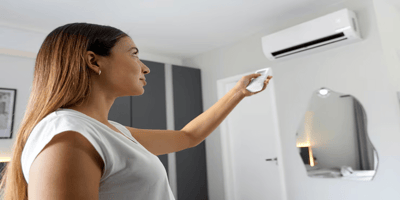Say Goodbye to Mold: A Comprehensive Guide to AC Cleaning
Clean air conditioning units play a pivotal role in maintaining a healthy and comfortable indoor environment. As the sweltering heat of summer or the chilly winds of winter prompt us to rely on our air conditioner for temperature control, it's easy to overlook the vital role they play in the quality of the air we breathe.
In this comprehensive guide, we will shed light on the critical significance of clean air conditioning units and address a common and often hidden problem: mold within these systems. Mold is an insidious intruder that can silently thrive in the dark recesses of your AC unit, compromising indoor air quality and potentially posing health risks to you and your loved ones.
The purpose of this guide is to empower you with the knowledge and tools needed to bid farewell to mold and other contaminants within your AC system. By the end of this journey, you will gain a comprehensive understanding of the importance of AC cleaning, discover the step-by-step process to effectively clean your unit, learn how to remove and prevent mold growth, and even explore the option of professional cleaning when necessary.
Join us in this endeavor to ensure that your air conditioning system not only keeps you cool or warm but also provides you with clean and healthy air to breathe. Let's embark on this journey together to say goodbye to mold and welcome a breath of fresh, pure air into your indoor spaces.
Understanding the Importance of AC Cleaning
Regular AC cleaning is a fundamental aspect of maintaining indoor air quality and ensuring a healthy living environment. While many of us rely on air conditioning systems to keep our homes comfortable, we often overlook the fact that these systems can become breeding grounds for a variety of contaminants, with mold being one of the most troublesome.
Maintaining Indoor Air Quality: One of the primary reasons for regular AC cleaning is to preserve and improve indoor air quality. Your air conditioning system circulates air throughout your home, which means that any pollutants or contaminants present within the system can be distributed throughout your living spaces. Over time, dust, dirt, pollen, pet dander, and mold spores can accumulate within the air conditioner components, diminishing the quality of the air you breathe.
Health Risks Associated with Mold and Contaminants: Mold, in particular, poses a significant threat when it finds a home in your AC system. As mold spores thrive in dark, damp conditions, AC units provide an ideal environment for their growth. When mold proliferates within the system, it can release spores into the air, which, when inhaled, can lead to a range of health problems. These health risks may include:
- Respiratory Issues: Mold spores can trigger or exacerbate respiratory conditions such as asthma and allergies. Prolonged exposure may lead to coughing, sneezing, congestion, and even more severe respiratory symptoms.
- Allergic Reactions: Individuals who are sensitive to mold can experience allergic reactions, including skin rashes, itchy eyes, and runny noses.
- Irritation: Mold spores and other contaminants can irritate the eyes, throat, and skin, causing discomfort and a general feeling of unwellness.
- Infections: In some cases, mold exposure can lead to fungal infections, particularly in individuals with weakened immune systems.
By understanding the importance of AC cleaning, you take proactive steps to mitigate these health risks and ensure that the air circulated throughout your home is clean, fresh, and free from harmful contaminants. In the following sections of this guide, we will delve into the step-by-step process of air conditioner cleaning, including mold removal and preventive measures, empowering you to breathe easier and live in a healthier indoor environment.
Tools and Supplies
To effectively clean your air conditioning unit and ensure that it operates efficiently and produces clean air, you'll need a selection of tools and supplies. Here's a list of the necessary items you'll require, along with some guidance on where to obtain them:
- Screwdrivers:
- Phillips-head and flathead screwdrivers are essential for removing screws and accessing various components of your AC unit. You likely already have these in your toolbox, but if not, they are readily available at hardware stores, home improvement centers, or online retailers.
- Soft Brushes:
- Soft-bristle brushes, such as paintbrushes or specialized HVAC brushes, are handy for dusting and cleaning delicate components like the evaporator and condenser coils. These brushes are available at most home improvement stores and online.
- Cleaning Agents:
- You'll need appropriate cleaning agents to tackle dirt, grime, and mold. Mild detergents, warm water, and a mixture of water and vinegar are often effective for cleaning various AC components. You can find these cleaning agents in your home, and no special purchase is usually required.
- Replacement Filters:
- If your air conditioner uses disposable filters, it's a good idea to have replacements on hand. You can find compatible filters at home improvement stores, HVAC supply shops, or online retailers. Make sure to purchase the correct filter size and type for your specific AC unit.
- Safety Gear:
- Personal protective equipment (PPE) is essential when working with AC units. This includes gloves, safety goggles, and a dust mask to protect yourself from allergens and contaminants. These items are often available at hardware stores or online.
- Vacuum Cleaner with HEPA Filter:
- A vacuum cleaner with a HEPA filter is useful for capturing dust and debris that may be released during the cleaning process. If you don't already have one, vacuum cleaners with HEPA filters are widely available in appliance stores and online retailers.
- Fin Comb:
- A fin comb is a tool used to straighten and clean the fins on your AC's condenser coil. These are available at HVAC supply stores and online retailers.
- Coil Cleaner:
- For deep cleaning of the evaporator and condenser coils, you may need a specialized coil cleaner. These can be found at HVAC supply stores or online retailers.
- Drain Line Cleaning Kit (Optional):
- If your AC unit has a clogged condensate drain line, a drain line cleaning kit, which includes a brush or a suction pump, can be beneficial. These kits are available at hardware stores, plumbing supply shops, or online.
Remember that safety should always be a priority when working with your AC unit. Ensure that you have the necessary safety gear and use caution throughout the cleaning process. Most of these tools and supplies can be obtained from local stores, but online retailers provide a convenient option for purchasing any specific items you may need for AC cleaning.
Step-by-Step AC Cleaning Process. How to Get Mold Out of an Air Conditioner?
Cleaning your air conditioning (AC) unit is a crucial task to ensure it operates efficiently and maintains healthy indoor air quality. Here's a detailed, step-by-step guide on how to clean your AC unit:
- Safety Precautions:
- Before starting, ensure the AC unit is powered off at the breaker panel to prevent any accidental startup during cleaning.
- Put on safety gear, including gloves, safety goggles, and a dust mask to protect yourself from allergens and contaminants.
- Remove and Clean the Air Filter:
- Locate the air filter in your AC unit. It's typically found behind a front panel or grille.
- Carefully remove the filter and assess its condition. If it's disposable, replace it with a new filter of the same size and type. If it's reusable, clean it by vacuuming away dust and debris or washing it with mild detergent and warm water. Allow the filter to dry completely before reinstalling it.
- Cleaning the Evaporator Coil:
- The evaporator coil is typically located above the furnace or inside the indoor unit. Access it by removing the access panel or grille.
- Use a soft brush to gently remove dust and debris from the coil. Be careful not to bend or damage the delicate fins.
- For a deeper clean, spray a coil cleaner on the coil as per the product instructions. Rinse it off with water after the recommended dwell time.
- Allow the coil to dry completely before reassembling.
- Cleaning the Condenser Coil:
- Locate the condenser coil, which is usually in the outdoor unit. Ensure the power is off at the breaker panel.
- Remove debris, leaves, and grass clippings from around the outdoor unit. Trim vegetation to provide proper airflow.
- Use a fin comb to straighten any bent fins on the condenser coil.
- Apply a coil cleaner to the condenser coil following the product instructions. Rinse thoroughly with a hose after the recommended dwell time.
- Allow the coil to dry before restoring power to the unit.
- Cleaning the Condensate Drain Line:
- Find the condensate drain line, usually located near the indoor unit. It may be a PVC pipe.
- Carefully disconnect the drain line from the unit and the drainage pan.
- Use a drain line cleaning kit, a wet/dry vacuum, or a long, flexible brush to clear any clogs and debris from the drain line.
- Reattach the drain line securely.
- Removing and Cleaning the Blower Fan (if accessible):
- Access the blower fan by removing the access panel on the indoor unit.
- Use a soft brush to clean the blower fan blades and motor housing.
- If necessary, lubricate the motor bearings with oil (if applicable to your unit) as per the manufacturer's instructions.
- Cleaning or Replacing Other Accessible Components:
- Check other accessible components, such as the blower motor and any removable panels, for dust and debris. Clean or replace them as needed.
- Reassembling the Unit:
- Carefully reassemble all components in the reverse order of disassembly.
- Ensure all access panels and grilles are securely fastened.
- Restore power to the AC unit at the breaker panel.
By following this step-by-step air conditioner cleaning process, you can help ensure that your air conditioning system operates efficiently, maintains good indoor air quality, and prolongs its lifespan. Regular maintenance like this can save you money on energy bills and prevent potential health issues associated with poor indoor air quality.
Mold Removal and Prevention
Mold can be a persistent problem in air conditioning systems, affecting both indoor air quality and the efficiency of your unit. Here, we'll discuss specific techniques for removing mold from AC components and offer valuable tips on preventing its return.
Mold Removal Techniques:
- Safety First: Before you begin, ensure you are wearing the appropriate safety gear, including gloves, safety goggles, and a dust mask.
- Inspect for Mold: Check your air conditioner components, including the evaporator and condenser coils, blower fan, and drain pan, for any signs of mold. Mold is often recognizable by its black or greenish appearance.
- Turn Off Power: Ensure the air conditioner unit is powered off at the breaker panel to prevent any accidental startup during mold removal.
- Cleaning Mold on Surfaces:
- Mix a solution of equal parts water and vinegar or use a commercial mold cleaner.
- Dip a soft brush or cloth into the solution and scrub the affected areas gently.
- Rinse thoroughly with clean water and allow the components to dry completely before reassembling.
- Cleaning Mold in Drain Lines: If mold is present in the condensate drain line, use a drain line cleaning kit or a mixture of bleach and water to disinfect and remove the mold. Follow product instructions carefully.
- Replace Insulation (if necessary): If the insulation around the evaporator coil or other components is heavily contaminated with mold and cannot be effectively cleaned, it may need replacement.
- Seek Professional Help: If you find extensive mold growth or are uncomfortable with the removal process, consider hiring a professional HVAC technician who specializes in mold remediation.
Preventing Mold Growth:
- Regular Maintenance: Implement a regular AC maintenance schedule, which includes cleaning and inspecting the unit at least once a year. Clean or replace air filters regularly, as dirty filters can contribute to mold growth.
- Control Humidity: Mold thrives in damp conditions. Keep indoor humidity levels below 60% to discourage mold growth. You can use dehumidifiers to maintain optimal humidity levels.
- Ventilation: Ensure proper ventilation in your home. Use exhaust fans in bathrooms and kitchens to remove excess moisture and allow fresh air to circulate.
- Seal Leaks: Inspect and seal any leaks in your AC system's ductwork, as moisture can enter and promote mold growth.
- Sunlight and Air Circulation: Allow natural sunlight into your home whenever possible, as mold dislikes ultraviolet (UV) light. Keep curtains and blinds open during the day to facilitate air circulation.
- Professional Maintenance: Consider scheduling professional HVAC maintenance, which can include thorough cleaning and inspection to prevent mold growth and ensure the system is functioning efficiently.
By following these mold removal techniques and prevention tips, you can help ensure that your air conditioning system remains mold-free, promoting both clean indoor air and the longevity of your AC unit.
Conclusion:
In this comprehensive guide, we've embarked on a journey to say goodbye to mold within our air conditioning systems. We've explored the critical importance of AC cleaning, delved into the step-by-step process of removing mold and contaminants, and discussed essential preventive measures to ensure mold doesn't return.
By understanding why AC cleaning is crucial and how mold can affect indoor air quality and health, you've taken the first step toward a cleaner, healthier living environment. The step-by-step air conditioner cleaning process has armed you with the knowledge and tools to tackle mold removal effectively, from safely cleaning air filters to disinfecting condensate drain lines.
In the realm of prevention, we've uncovered strategies for maintaining a mold-free AC system. Regular maintenance, humidity control, ventilation, and professional assistance all play essential roles in ensuring your air conditioner remains a source of cool, clean air.
As you implement these practices, you're not only safeguarding your health and the well-being of your loved ones but also optimizing the efficiency and lifespan of your AC unit. Clean, well-maintained air conditioning not only cools or heats your space but also provides a breath of fresh, pure air that invigorates and rejuvenates.
To prevent mold you can also use Sensibo Plus. With Sensibo Plus, you can now enjoy enhanced protection against mold growth in your HVAC system. This innovative feature is designed to help maintain a healthier and more comfortable indoor environment for you and your loved ones. Say goodbye to the worries of mold-related issues and experience peace of mind with Sensibo Plus and its Anti-Mold feature.
We hope this guide has equipped you with the knowledge and confidence to bid farewell to mold and embrace the benefits of a clean, efficient, and mold-free air conditioning system. As you continue on this journey, remember that a healthier home begins with clean air, and your air conditioner maintenance is a powerful step toward achieving that goal. Say goodbye to mold, and say hello to a fresher, healthier indoor environment.


































.jpg)

.jpg?height=200&name=image6%20(2).jpg)

